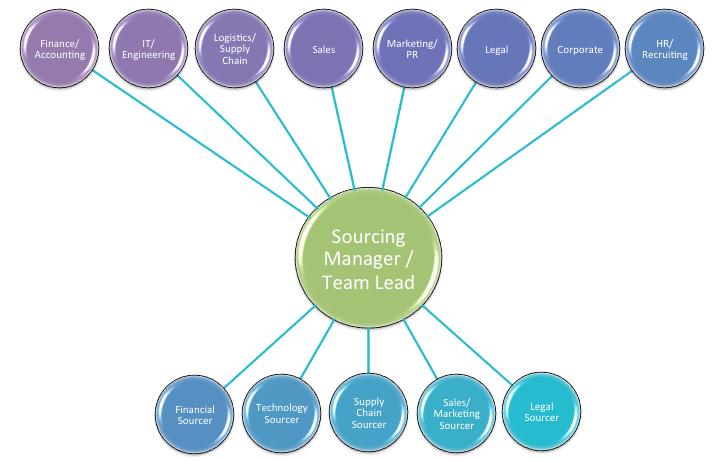When you’re working in an organization where there are more than five recruiters who need sourcing support, it’s probably a good time to expand your research team! Any good sourcer will tell you that they can effectively support 2 – 6 active recruiters on their own. Any more than that and you’re getting stretched pretty thin. I couldn’t agree more!
Here are some ideas to help you determine the best working structure for your sourcing team as it continues to grow and thrive. These ideas are the compilation of consultation with seasoned sourcers who have developed successful sourcing teams within their companies.
To start off, let me show an example of the structure of one of my previous employers – a recruitment agency franchise:

You can replace ‘Franchise Office’ with your individual recruiters, or with your desk specialty teams. In this example, all of the franchise offices were supported by the Corporate team. At this company, I was on the Corporate team, therefore I supported each of the offices in their sourcing needs in a sort-of one-person Central Research capacity. At the time, there were 50 offices, and while not every one of them used my sourcing services, a number of them did – I was very busy to say the least!
For organizing Central Research, the organizational structure looks pretty much the same whether you’re talking about a Corporate or an Agency setting. This is typically what support from Central Research looks like:

Or, if you want to view it from an internal/Corporate standpoint:

As one might imagine, this would be a tough thing for one sourcer to manage. When working with an Agency, not only do you have multiple offices, but multiple industries, which only complicates the situation. In a Corporate setting, not having a deeper structure and tight communication standards built into that Central Research circle would create mass chaos. Putting together a strong sourcing team in this case is essential to thoroughly support all the industries, offices, and/or business units.
There are several ways to approach this and be successful.
Generalist Sourcing
The first way would be to bring on more sourcers and train them as generalists. This is what it might look like:

This could get confusing if the sourcers do not specialize in a specific industry, or if there is not one point of contact for the Central Research team. The sourcers are simply given searches based upon their current workload or perhaps good relationships built with specific recruiters. In a small office or recruiting organization, this could work, but it is not a scalable model. If you intend to grow, you will eventually outgrow this sourcing model.
Basic Industry or Business Unit Specialization Sourcing
A second way of organizing the sourcing team would be to assign sourcers to an arbitrary grouping of recruiters. Let’s say one sourcer for every three recruiters, for example’s sake. Some issues arise in this situation:
- How do you group your sourcing/recruiting teams? By related industry? By number of clients held by the recruiter? By tenure (pairing a senior recruiter with a junior)?
- Do you train the sourcer as a generalist or have them specialize in one or two specific industries?
- If your assigned sourcer is not available, what happens then? Do you turn to the sourcer for another group? What if that person is already swamped?
A better organization of the sourcing team could be represented by allowing each sourcer to specialize in an industry or a job function. For example: a technology sourcer would be able to support the IT hardware recruiter as well as the medical devices recruiter. A healthcare researcher would also be able to support the medical devices recruiter but in addition would be able to help out a physician or nurse recruiter. Here is how this organization might look:

While this is a more specialized method of organization, it still can get confusing if each researcher is an independent ‘unit’ with no single point of contact.
Business Unit Liaison Sourcing
In my personal opinion, the best method of organizing a sourcing team is to have one point of contact for all search requests. Think of this person as your proxy server or your team liaison. This individual, probably the team manager, receives all the search requests and distributes them. Distribution of the search requests can depend on a couple of variables:
- Area(s) of specialization of the sourcer
- Existing workload and availability of the sourcer

Modified Business Unit Liaison Sourcing
Or, when you have a much larger organization, you can break down your sourcing team even further to serve small groups of business units while still keeping a centralized feel to it:

The nice thing about either of these last two models is that several of the specializations for the sourcers overlap. This way, if one sourcer is unavailable to take on a new search project, it can simply be distributed to another sourcer who specializes in a related industry. Having sourcers who specialize, in my opinion, is as important as having a recruiter who specializes. You become familiar with the players in your niche when you specialize and can therefore pinpoint companies, resources, and networks much faster when presented with a new assignment. When you are a generalist, while you can support everyone, you generally become a ‘jack of all trades and a master of none.’ Trust me – I know!
I believe that most good sourcing teams are laid out in a similar fashion as this last two models. Design your team to have one or a small handful of contact points for the recruiters to send their requests to, who then distribute these requests amongst their team in order to complete search assignments in a more timely fashion. This will lead to more productivity, happier recruiters and clients, and more money in your pockets!
